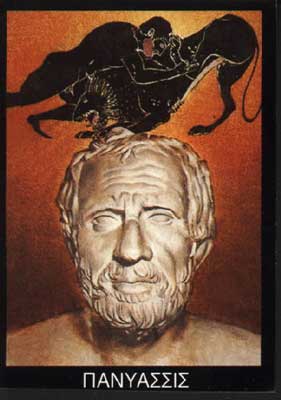.

Panyasis (more correctly, Panyassis) was a native of Halicarnassus, and probably the maternal uncle of Herodotus. He began to be known about 489 BC, continued in reputation till 467 BC, in which year he is placed by Suidas, and was put to death by Lygdamis (c. 454 BC), tyrant of Halicarnassus, probably about the same time that Herodotus left his native city, that is, about B.C. 457. Ancient writers mention two poems by Panyasis. Of these the most celebrated was entitled Heracleia or Heracleias and gave a detailed account of the exploits of Hercules. It consisted of fourteen books and nine thousand verses, and appears, as far as we can judge from the references to it in ancient writers, to have passed over briefly the adventures of the hero which had been related by previous poets, and to have dwelt chiefly upon his exploits in Asia, Libya, etc. An outline of the contents of the various books, as far as they can be restored, is given by Miiller, in an appendix to his work on the Dorians. The other poem of Panyasis bore the name of lonica, and contained seven thousand verses. It gave the history of Neleus, Codrus, and the Ionic colonies. Suidas says it was written in pentameters ;but it is improbable that, at so early a period, a poem of such a length was written simply in pentameters ; still, as no fragments have come down to us, we have no certain information on the subject.
We do not know what impression the poems of Panyasis made upon his contemporaries and their immediate descendants, but it was probably not great, since he is not mentioned by any of the great Greek writers.
But in later times his works were extensively read, and much admired. The Alexandrine grammarians ranked him with Homer, Hesiod, Pisander, and Antimachus, as one of the five principal epic poets, and some even went so far as to compare him with Homer. Panyasis occupied an intermediate position between the later cyclic poets and the studied efforts of Antimachus, who is stated to have been his pupil. From two of the longest fragments which have come down to us, it appears that Panyasis kept close to the old Ionic form of epic poetry, and had imbibed no small portion of the Homeric spirit. The fragments of the Heraclea are given in the collections of the Greek poets by Winterton, Brunck, Boissonade, and Gaisford ; in Diintzer s Fragments of Greek epic poetry ; in Tzschirner s De Panyasidis Vita et Canmnibus Dissertatio, Vratisl., 1836 ; and in Funcke s De Panyasidis Vita ac Poesi Dissertatio, Bonn, 1837.
| Ancient Greece
Science, Technology , Medicine , Warfare, , Biographies , Life , Cities/Places/Maps , Arts , Literature , Philosophy ,Olympics, Mythology , History , Images Medieval Greece / Byzantine Empire Science, Technology, Arts, , Warfare , Literature, Biographies, Icons, History Modern Greece Cities, Islands, Regions, Fauna/Flora ,Biographies , History , Warfare, Science/Technology, Literature, Music , Arts , Film/Actors , Sport , Fashion --- |
Retrieved from "http://en.wikipedia.org"
All text is available under the terms of the GNU Free Documentation License

